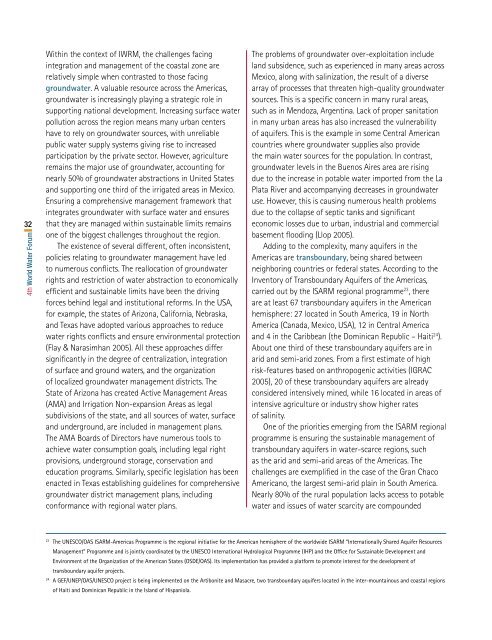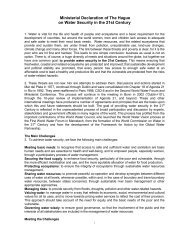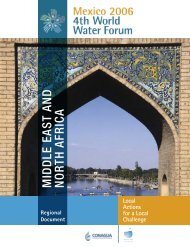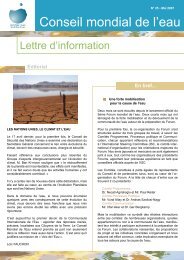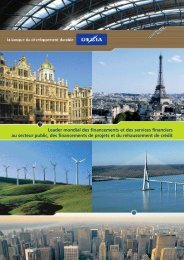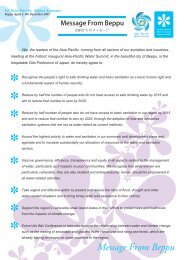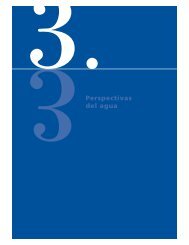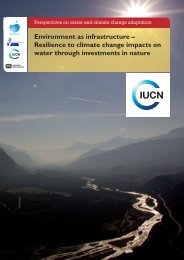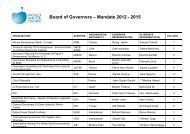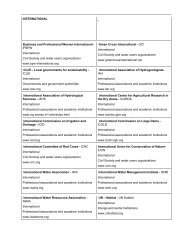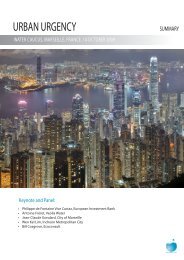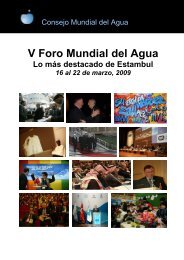Americas ok.indd - World Water Council
Americas ok.indd - World Water Council
Americas ok.indd - World Water Council
You also want an ePaper? Increase the reach of your titles
YUMPU automatically turns print PDFs into web optimized ePapers that Google loves.
324th <strong>World</strong> <strong>Water</strong> ForumWithin the context of IWRM, the challenges facingintegration and management of the coastal zone arerelatively simple when contrasted to those facinggroundwater. A valuable resource across the <strong>Americas</strong>,groundwater is increasingly playing a strategic role insupporting national development. Increasing surface waterpollution across the region means many urban centershave to rely on groundwater sources, with unreliablepublic water supply systems giving rise to increasedparticipation by the private sector. However, agricultureremains the major use of groundwater, accounting fornearly 50% of groundwater abstractions in United Statesand supporting one third of the irrigated areas in Mexico.Ensuring a comprehensive management framework thatintegrates groundwater with surface water and ensuresthat they are managed within sustainable limits remainsone of the biggest challenges throughout the region.The existence of several different, often inconsistent,policies relating to groundwater management have ledto numerous conflicts. The reallocation of groundwaterrights and restriction of water abstraction to economicallyefficient and sustainable limits have been the drivingforces behind legal and institutional reforms. In the USA,for example, the states of Arizona, California, Nebraska,and Texas have adopted various approaches to reducewater rights conflicts and ensure environmental protection(Flay & Narasimhan 2005). All these approaches differsignificantly in the degree of centralization, integrationof surface and ground waters, and the organizationof localized groundwater management districts. TheState of Arizona has created Active Management Areas(AMA) and Irrigation Non-expansion Areas as legalsubdivisions of the state, and all sources of water, surfaceand underground, are included in management plans.The AMA Boards of Directors have numerous tools toachieve water consumption goals, including legal rightprovisions, underground storage, conservation andeducation programs. Similarly, specific legislation has beenenacted in Texas establishing guidelines for comprehensivegroundwater district management plans, includingconformance with regional water plans.The problems of groundwater over-exploitation includeland subsidence, such as experienced in many areas acrossMexico, along with salinization, the result of a diversearray of processes that threaten high-quality groundwatersources. This is a specific concern in many rural areas,such as in Mendoza, Argentina. Lack of proper sanitationin many urban areas has also increased the vulnerabilityof aquifers. This is the example in some Central Americancountries where groundwater supplies also providethe main water sources for the population. In contrast,groundwater levels in the Buenos Aires area are risingdue to the increase in potable water imported from the LaPlata River and accompanying decreases in groundwateruse. However, this is causing numerous health problemsdue to the collapse of septic tanks and significanteconomic losses due to urban, industrial and commercialbasement flooding (Llop 2005).Adding to the complexity, many aquifers in the<strong>Americas</strong> are transboundary, being shared betweenneighboring countries or federal states. According to theInventory of Transboundary Aquifers of the <strong>Americas</strong>,carried out by the ISARM regional programme 23 , thereare at least 67 transboundary aquifers in the Americanhemisphere: 27 located in South America, 19 in NorthAmerica (Canada, Mexico, USA), 12 in Central Americaand 4 in the Caribbean (the Dominican Republic – Haiti 24 ).About one third of these transboundary aquifers are inarid and semi-arid zones. From a first estimate of highrisk-features based on anthropogenic activities (IGRAC2005), 20 of these transboundary aquifers are alreadyconsidered intensively mined, while 16 located in areas ofintensive agriculture or industry show higher ratesof salinity.One of the priorities emerging from the ISARM regionalprogramme is ensuring the sustainable management oftransboundary aquifers in water-scarce regions, suchas the arid and semi-arid areas of the <strong>Americas</strong>. Thechallenges are exemplified in the case of the Gran ChacoAmericano, the largest semi-arid plain in South America.Nearly 80% of the rural population lacks access to potablewater and issues of water scarcity are compounded23The UNESCO/OAS ISARM-<strong>Americas</strong> Programme is the regional initiative for the American hemisphere of the worldwide ISARM “Internationally Shared Aquifer ResourcesManagement” Programme and is jointly coordinated by the UNESCO International Hydrological Programme (IHP) and the Office for Sustainable Development andEnvironment of the Organization of the American States (OSDE/OAS). Its implementation has provided a platform to promote interest for the development oftransboundary aquifer projects.24A GEF/UNEP/OAS/UNESCO project is being implemented on the Artibonite and Masacre, two transboundary aquifers located in the inter-mountainous and coastal regionsof Haiti and Dominican Republic in the Island of Hispaniola.


